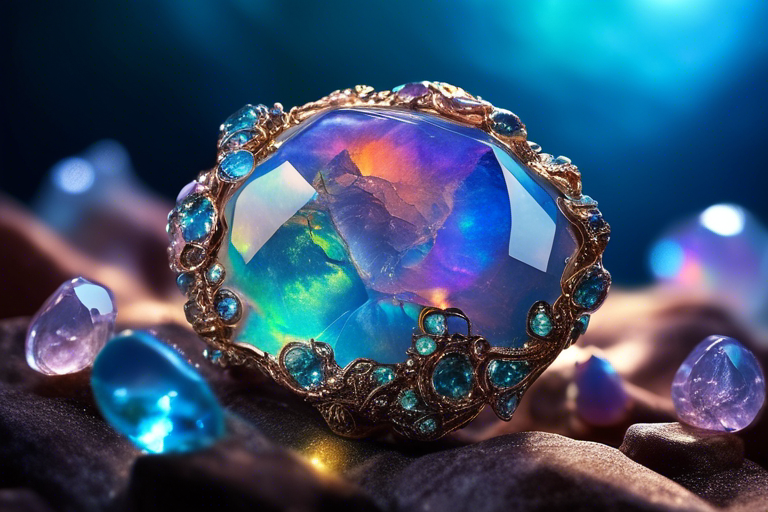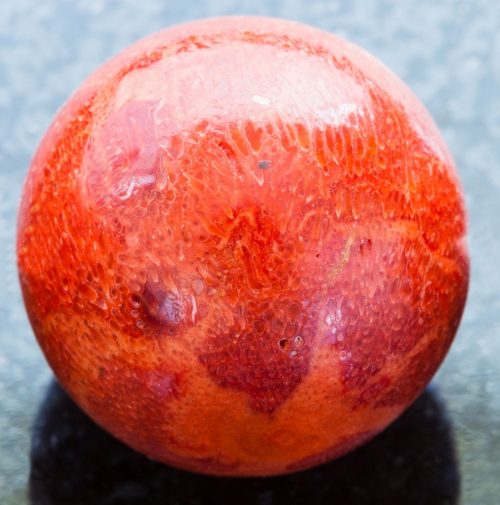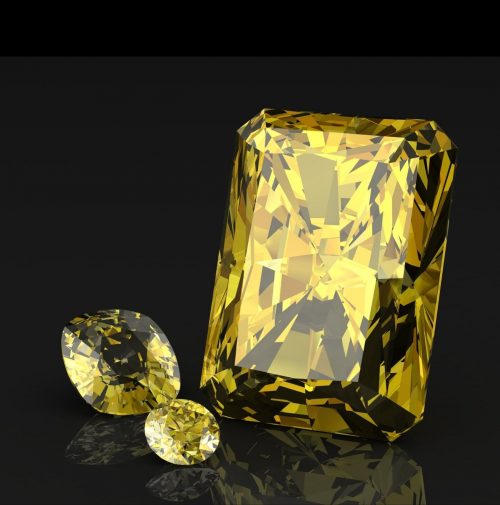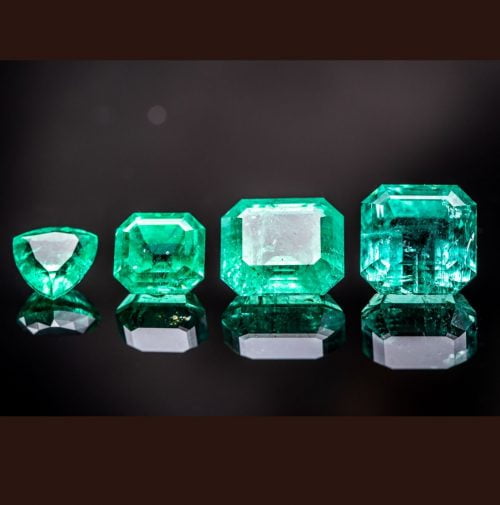Opal: The Radiant Gem That Captivates Hearts and Shines with Rainbow Colors

Introduction
When it comes to capturing hearts and mesmerizing the beholder with its stunning display of colors, no gemstone compares to the opal. With its ethereal beauty and unique play of light, opal has been enchanting people for centuries. From ancient civilizations to contemporary jewelry enthusiasts, this gemstone continues to captivate with its iridescent charm.
- Opals are known for their ability to display a vibrant array of colors, often referred to as the “play-of-color.” This phenomenon occurs due to the delicate arrangement of silica spheres within the stone, which diffract light and produce a shimmering effect of endless hues. From fiery oranges and reds to calming blues and greens, opals truly present a kaleidoscope of colors.
- This precious gem holds a significant place in various cultures and beliefs. For instance, in ancient Rome, it was believed that opals symbolized good luck and hope. In Aboriginal Australian folklore, opals are considered to be the “creator’s footprint.” Even today, opals are treasured as birthstones for October and sought after by collectors and jewelry enthusiasts around the world.
Whether you’re drawn to its mesmerizing colors or the mythical charm it exudes, opals have an undeniable allure that captures the heart and ignites the imagination. Join us as we embark on a journey to explore the radiant world of opals and discover their undeniable beauty.
History and Symbolism of Opal
Opals have a rich history dating back thousands of years. The earliest documented evidence of opal use can be traced back to ancient civilizations such as the Egyptians and the Greeks. The Romans, in particular, held opals in high regard and believed them to bring good fortune. Opals were also highly prized by the Aztecs, who believed that they embodied the beauty of the rainbow.
In terms of symbolism, opals have been associated with various meanings throughout history. In ancient times, opals were believed to possess the power of foresight and prophecy. They were also thought to bring protection and luck to the wearer. In more recent times, opals have come to symbolize hope, purity, and creativity.
Types of Opal Gemstones
Opals come in a variety of types, each with its own unique characteristics and colors. The most well-known types of opals include black opal, white opal, fire opal, and boulder opal.
- Black opals are highly valued for their dark body color, which allows the play-of-color to stand out vividly. These opals are typically found in Lightning Ridge, Australia, and are known for their intense display of colors, ranging from deep blues and greens to vibrant reds and oranges.
- White opals, on the other hand, have a light body color that enhances the play-of-color. These opals are found in various parts of Australia, including Coober Pedy and Mintabie. They exhibit a softer and more delicate range of colors, often featuring pastel hues of blue, green, and pink.
- Fire opals, as the name suggests, display a fiery range of colors, including vibrant oranges, yellows, and reds. These opals are typically found in Mexico and are highly prized for their intense and warm hues.
Boulder opals are unique in that they form within ironstone or sandstone boulders. These opals often have a dark body color, with the play-of-color appearing as veins or patches. Boulder opals can be found in Queensland, Australia, and are revered for their natural beauty and striking patterns.
Characteristics and Properties of Opal
Opals are composed of hydrated silica, which gives them their characteristic play-of-color. The internal structure of opals consists of tiny silica spheres arranged in a three-dimensional lattice. When light enters the opal, it interacts with these spheres, causing diffraction and the resulting display of colors.
One of the most fascinating aspects of opals is their ability to exhibit different colors from different angles. This phenomenon, known as opalescence, adds to their captivating allure. Opals can also vary in transparency, with some being translucent and others more opaque.
In terms of hardness, opals range from 5.5 to 6.5 on the Mohs scale. This makes them relatively soft compared to other gemstones, such as diamonds or sapphires. It is important to handle opals with care to avoid scratches or damage.
How Opal is Formed
Opals are formed through a unique process that takes place over millions of years. They are typically created in areas with high silica content, such as volcanic regions or sedimentary basins. The formation of opals begins when water containing dissolved silica seeps into cracks and cavities in the earth.
Over time, the water evaporates, leaving behind solid deposits of silica. As more silica is deposited, the silica spheres begin to form and arrange themselves in a lattice structure. The process of opal formation is slow and delicate, often taking thousands of years for a substantial opal to develop.
The colors and patterns seen in opals are influenced by various factors, including the size and arrangement of the silica spheres, as well as the presence of impurities and mineral inclusions. These factors contribute to the unique and mesmerizing play-of-color that opals are known for.
Opal Mining and Production
Opal mining is a fascinating and often challenging process that involves extracting opals from the earth. The majority of opal mining takes place in Australia, where the gemstone is abundant. The two main methods of opal mining are underground mining and open-cut mining.
Underground mining involves excavating tunnels and shafts to reach the opal-bearing layers. Miners use hand tools and machinery to extract the opals, often working in cramped and challenging conditions. Open-cut mining, on the other hand, involves removing the overlying layers of dirt and rock to access the opal deposits.
Once the opals are extracted, they go through a process of cleaning, cutting, and polishing to enhance their beauty and reveal the full play-of-color. Skilled lapidaries carefully shape the opals into various cuts and cabochons, highlighting their unique colors and patterns.
Popular Opal Jewelry Designs and Settings
Opals have long been favored for their beauty and versatility in jewelry design. From delicate earrings to statement rings, opals can be incorporated into a wide range of jewelry styles. Some popular opal jewelry designs include:
- Opal Solitaire Rings: A single opal gemstone set in a ring, often accompanied by accent diamonds or other gemstones.
- Opal Pendant Necklaces: Opals suspended from a chain or a cord, creating a stunning focal point for necklaces.
- Opal Stud Earrings: Small opal gemstones set in simple stud settings, perfect for everyday wear.
- Opal Bracelets: Opals set in a chain or a bangle, creating a captivating and colorful wrist adornment.
When it comes to settings, opals are often set in bezel or prong settings to protect the delicate gemstone and allow maximum light to enter. The choice of metal, such as gold or silver, can also enhance the overall appearance of the opal jewelry.
Caring for Your Opal Jewelry
Opals are delicate gemstones that require special care to ensure their longevity and beauty. Here are some tips for caring for your opal jewelry:
- Avoid exposing opals to harsh chemicals, such as household cleaners or perfumes, as they can damage the gemstone.
- Remove opal jewelry before engaging in activities that may cause physical stress or impact, such as sports or gardening.
- Clean opals gently using a soft cloth and mild soapy water. Avoid using ultrasonic cleaners or steamers, as they can damage the gemstone.
- Store opal jewelry in a soft pouch or a box to protect them from scratches and to prevent them from coming into contact with other gemstones or metals.
By following these care guidelines, you can ensure that your opal jewelry remains vibrant and beautiful for years to come.
Famous Opal Gemstones and Their Stories
Throughout history, there have been several famous opal gemstones that have captured the world’s attention. These gemstones have fascinating stories and have become iconic in their own right.
One such famous opal is the “Andamooka Opal,” discovered in Andamooka, South Australia, in the 1940s. This opal, known for its stunning play-of-color, was set in a necklace and worn by Queen Elizabeth II during her coronation in 1953. The Andamooka Opal remains a treasured piece of British royal jewelry.
Another notable opal is the “Aurora Australis,” the largest and most valuable black opal ever found. This opal, weighing over 180 carats, was discovered in Lightning Ridge, Australia, in 1938. The Aurora Australis displays a mesmerizing play-of-color, ranging from deep blues to vibrant reds, and is considered a national treasure of Australia.
These famous opals serve as a testament to the captivating beauty and allure of this gemstone, and their stories continue to inspire and fascinate gem enthusiasts around the world.
General FAQs for Opal Gemstone
What is the meaning of opal?
Opals have been associated with various meanings throughout history. They symbolize hope, purity, and creativity. In ancient times, opals were believed to possess the power of foresight and prophecy, bringing protection and luck to the wearer.
Is opal a birthstone?
Yes, opal is one of the birthstones for the month of October. It is treasured as a symbol of beauty and transformation.
Can opals be used in engagement rings?
Opals can be used in engagement rings, but they require careful consideration due to their relative softness. It is important to choose a protective setting and handle the ring with care to avoid damage to the opal.
Can opals be worn every day?
Opals can be worn every day, but they require special care to ensure their longevity. It is important to avoid exposing opals to harsh chemicals and physical stress, as they can damage the gemstone.
Can opals be repaired if they get damaged?
In some cases, damaged opals can be repaired by skilled gemstone artisans. However, the extent of the damage and the type of repair needed will determine if the opal can be restored to its original beauty.
How can I authenticate the quality of an opal?
Authenticating the quality of an opal requires a trained eye and expertise in gemstone evaluation. It is best to consult with a reputable gemologist or jeweler who can assess the opal’s quality based on factors such as color, play-of-color, and clarity.
Conclusion: Opal – A Captivating and Unique Gemstone
opals are truly captivating and unique gemstones that have the power to mesmerize and enchant. From their radiant display of colors to their rich symbolism and history, opals continue to captivate the hearts of people around the world.
Whether you’re looking to add a touch of ethereal beauty to your jewelry collection or seeking a meaningful birthstone for October, opals are a perfect choice. Their kaleidoscope of colors and their ability to ignite the imagination make them a truly magical gemstone.
To experience the beauty and power of opals, visit our website at 360 Real Astrology and explore our exquisite collection of opal jewelry. Our skilled gemologists and astrologers can guide you in selecting the perfect piece and provide you with the knowledge to harness the energy and benefits of this radiant gemstone.
Don’t miss out on the opportunity to own a piece of opal jewelry that will captivate hearts and shine with rainbow colors. Contact us today for an astrological birth-chart reading and take the first step towards a better life with the help of opals and the wisdom of astrology.
To book an astrological birth-chart reading, visit 360 Real Astrology – Contact Us.








Connect me